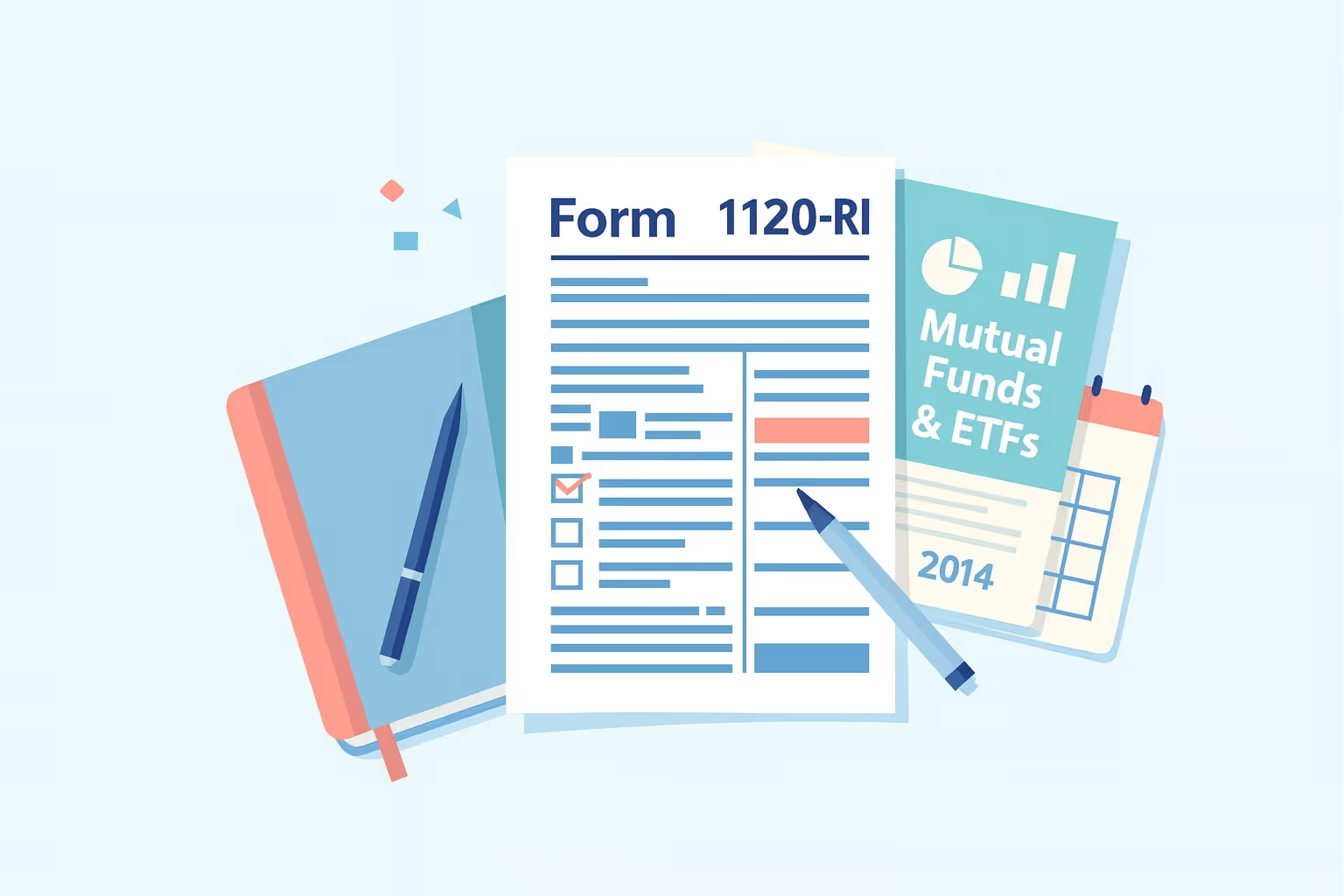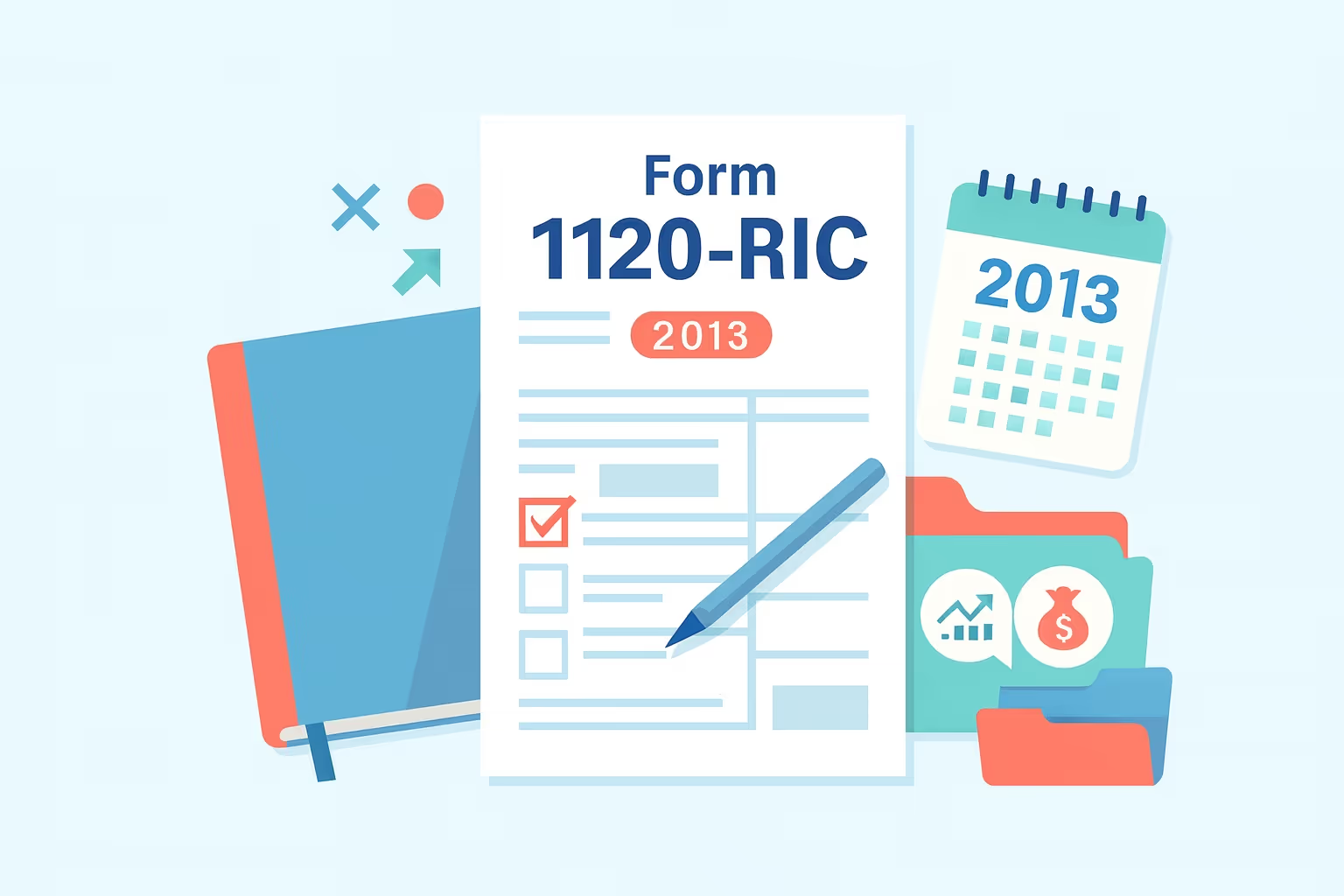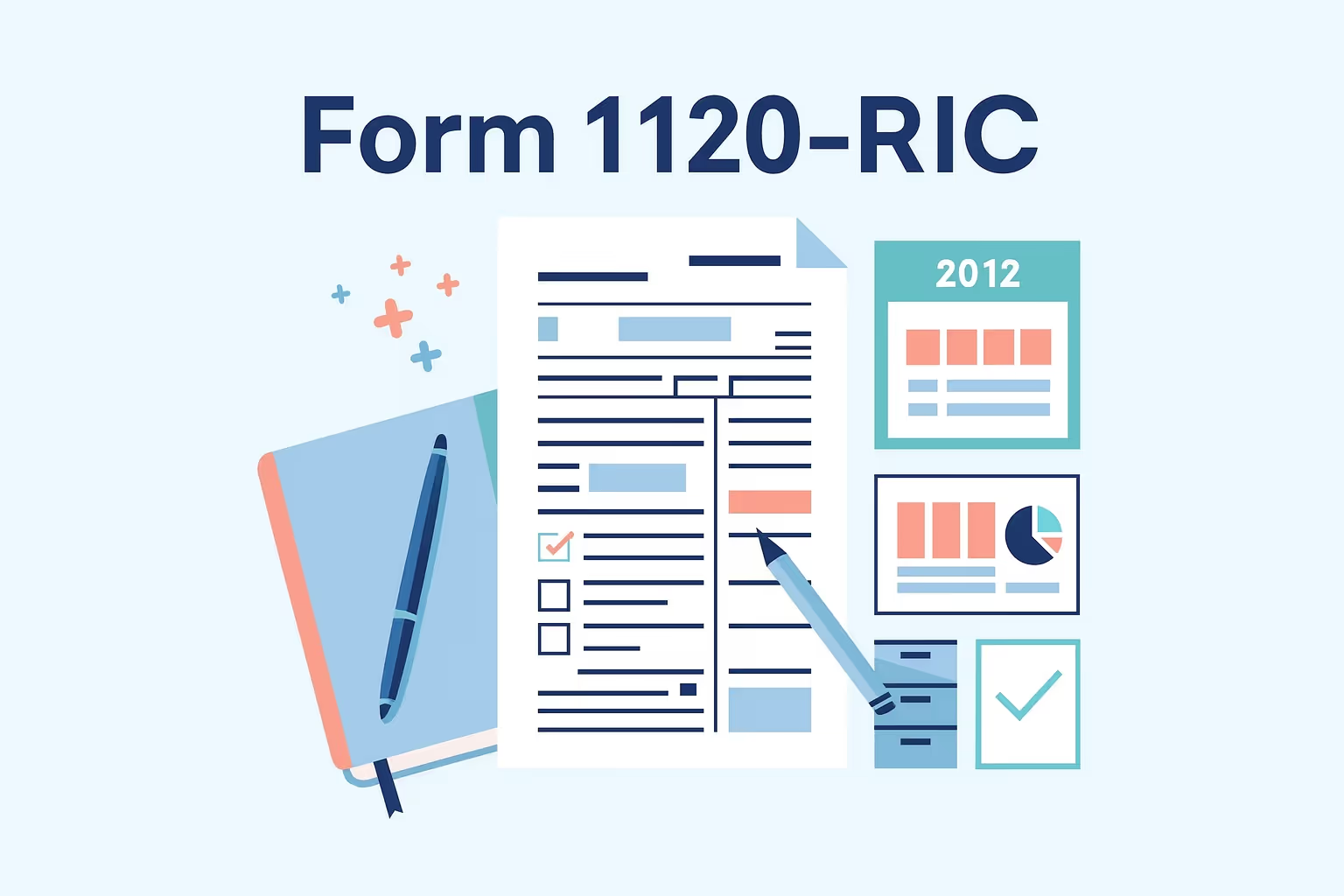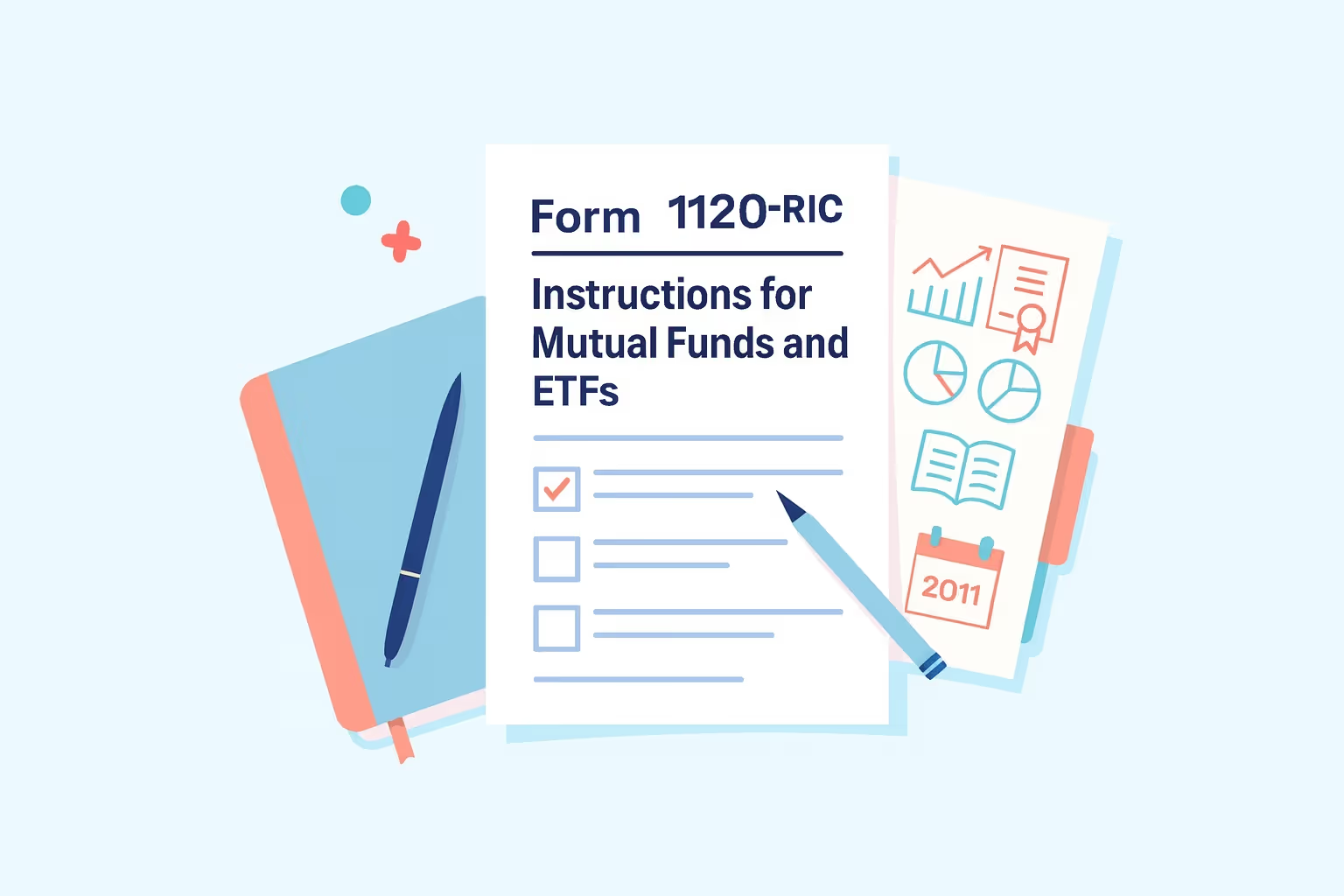Form 1120-RIC 2019 Instructions: Complete Filing Guide
Form 1120-RIC 2019 instructions serve as the official guide for regulated investment companies that need to file their annual income tax return with the Internal Revenue Service. This form applies to entities such as mutual funds, exchange-traded funds, and other investment companies that elect to be treated as RICs under the Investment Company Act. Filing this form ensures compliance with federal tax laws. It allows companies to report taxable income, deductions, credits, and distributions to shareholders accurately.
For regulated investment companies, submitting Form 1120-RIC is more than just a reporting requirement—it determines how their income tax liability is calculated and how income is distributed to shareholders. By properly completing the return, these companies can maintain their special tax status, avoid double taxation, and distribute most of their earnings directly to investors. Understanding the filing process helps RICs preserve their eligibility and prevent costly penalties for noncompliance.
The 2019 tax year introduced several adjustments that affected how investment companies file and report their net income and capital gains. These changes included new filing penalties and updates to specific schedules within the form. By following the correct instructions and IRS rules, corporations can ensure their income reporting and dividend distributions meet all applicable requirements.
Understanding Form 1120-RIC
Form 1120-RIC, U.S. Income Tax Return for Regulated Investment Companies, is the federal tax document used by corporations that qualify as regulated investment companies to report income, deductions, and distributions to the IRS. These companies include mutual funds, exchange-traded funds, and other registered investment entities that pool assets from investors to generate income through diversified securities and investments.
What Is a Regulated Investment Company?
A regulated investment company is a domestic corporation that elects to be treated as a regulated investment company under Subchapter M of the Internal Revenue Code and meets specific requirements set by the Securities and Exchange Commission. To qualify, the company must:
- Be registered under the Investment Company Act as a management company, unit investment trust, or business development company.
- Meet the income test by ensuring that at least 90% of its gross income comes from dividends, interest, gains on securities, or similar investment income.
- Satisfy the diversification test, which limits the percentage of the company’s assets invested in securities of a single issuer.
- Elect to be taxed as a regulated investment company by filing Form 1120-RIC with the IRS each tax year.
Purpose and Benefits
The primary purpose of filing Form 1120-RIC is to calculate and report the investment company’s taxable income and income tax liability. Qualifying as a regulated investment company allows the corporation to distribute most of its net investment income and capital gains to shareholders, avoiding double taxation at the corporate level. This pass-through feature benefits individual shareholders by allowing income to be taxed only once, thereby reducing the overall tax burden.
Common Types of RICs
- Mutual funds: Professionally managed investment companies that pool funds to buy diversified portfolios of securities.
- Exchange-traded funds (ETFs): Funds that trade on stock exchanges and typically track indexes or specific asset classes.
- Unit investment trusts (UITs): Fixed portfolios of securities with a set maturity date and minimal management activity.
- Real estate investment trusts (REITs): Companies that invest primarily in real estate assets and can qualify under similar tax principles.
By understanding Form 1120-RIC and its purpose, corporations can ensure proper compliance with IRS requirements, preserve RIC status, and provide tax-efficient investment opportunities for their shareholders.
What’s New for the 2019 Tax Year?
The IRS introduced several significant changes for regulated investment companies filing Form 1120-RIC for the 2019 tax year. These updates impacted how companies calculate penalties, manage charitable contributions, and report specific types of income. Understanding these updates helps investment companies remain compliant and accurately determine their income tax liability.
Key IRS Updates for 2019
- The minimum penalty for late filing increased to the smaller of the tax due or $435. This applies to returns filed more than 60 days after the due date.
- Contributions made to qualified disaster relief organizations between December 31, 2017, and February 19, 2020, are not subject to the 10 percent limitation on charitable deductions.
- Eligible employers operating in qualified disaster areas may use Form 5884-A to claim the Employee Retention Credit.
- Companies that hold controlled foreign corporations must continue reporting Section 965 transition tax amounts using Form 965-B.
These changes reflect the IRS’s continued effort to modernize compliance requirements while ensuring accurate reporting of taxable income and related credits for regulated investment companies.
Preparing to File Form 1120-RIC
Before completing Form 1120-RIC, every corporation must confirm that it meets all qualification requirements and has the necessary documentation ready. Proper preparation helps ensure accurate reporting and reduces the risk of penalties or delays in the processing of information.
Pre-Filing Checklist
- Verify that the company qualifies as a regulated investment company under Section 851.
- Gather records of all income sources, including dividends, interest, and capital gains.
- Collect detailed documentation of expenses and management fees.
- Calculate all dividend distributions made during the tax year.
- Prepare all required schedules and attachments for submission with the form.
- Confirm registration under the Investment Company Act and compliance with Securities and Exchange Commission requirements.
Common Preparation Mistakes
- Many corporations misclassify income when determining qualifying earnings, which can result in them failing the 90 percent income test required for regulated investment companies.
- Filers sometimes omit essential schedules, such as Schedule A for dividends paid or Schedule D for capital gains, which can lead to incomplete submissions and processing delays.
- Some companies use outdated IRS forms or incorrect line references from prior years, resulting in inaccurate calculations or noncompliance.
- Businesses often report incorrect employer identification numbers or inconsistent tax year dates, which can cause errors in matching records with IRS documentation.
- Filers occasionally enter mismatched totals between the main form and supporting schedules, creating discrepancies that may trigger an IRS review or correction notice.
Step-by-Step Instructions for Completing Form 1120-RIC
Filing Form 1120-RIC involves accurately completing multiple sections that report income, deductions, and tax computation details. Each part of the form corresponds to a specific category of financial reporting for regulated investment companies.
Part I – Income
- Report dividend income received from both domestic and foreign corporations.
- Include interest income from U.S. government obligations, corporate bonds, and other investments.
- Record payments received for lending securities as defined under Section 512(a)(5).
- Report any net short-term capital gains exceeding net long-term capital losses.
Part II – Deductions
- Record compensation of officers and salaries of employees, supported by Form 1125-E when applicable.
- Include business deductions such as rent, taxes, interest expense, and depreciation.
- Report management, custodian, and transfer agent fees, as well as accounting and audit expenses.
- Deduct legal, registration, and printing costs associated with fund operations.
Schedule A – Deduction for Dividends Paid
- Report ordinary and capital gain dividends paid during the tax year.
- Include dividends declared in the last quarter and paid by January 31 under Section 852(b)(7).
- Report Section 855(a) dividends paid within 12 months after year-end that qualify as prior-year distributions.
Schedule D – Capital Gains and Losses
- Record transactions involving the sale or exchange of securities.
- Report undistributed capital gains and compute related taxes where applicable.
- Attach supporting schedules and reconcile totals with reported net income.
Completing each part carefully helps ensure the accuracy of taxable income calculations and supports the investment company’s continued qualification as a regulated investment company under IRS regulations.
Payment and Estimated Tax Requirements
When filing Form 1120-RIC, corporations must understand how and when to pay taxes to remain compliant with IRS requirements. The amount owed depends on the investment company’s taxable income and the timing of payments made throughout the tax year.
Payment Methods
- Regulated investment companies are required to make tax deposits electronically through the Electronic Federal Tax Payment System.
- The Electronic Federal Tax Payment System is a free service offered by the Department of the Treasury.
- Payments must be scheduled by 8 p.m. Eastern Time on the business day before the due date.
- Companies can use their financial institutions or tax professionals to make these payments if they prefer not to handle them directly.
Estimated Tax Payments
- Corporations must make estimated tax payments if the total tax, less credits, is expected to be $500 or more.
- Payments are due on the 15th day of the fourth, sixth, ninth, and twelfth months of the tax year.
- Form 1120-W is used as a worksheet to calculate these installment payments.
- If overpayments occur, corporations may use Form 4466 to apply for a quick refund.
Timely electronic payments help prevent penalties and ensure that the investment company remains in good standing with the IRS throughout the tax year.
Required Schedules and Supporting Forms
Each regulated investment company must include specific schedules and attachments when filing Form 1120-RIC. These documents support calculations of income, deductions, and tax liability and provide additional information about the company’s assets and operations.
Mandatory Schedules
- Schedule A: Calculates the deduction for dividends paid during the tax year.
- Schedule B: Reports income from tax-exempt obligations.
- Schedule J: Determines total income tax liability.
- Schedule K: Provides other required information about the company’s structure and accounting methods.
- Schedule L: Summarizes balance sheets per company books.
- Schedule M-1: Reconciles differences between book and taxable income.
Additional Forms Commonly Required
- Form 8613 reports the 4 percent excise tax on undistributed income.
- Form 2438 calculates tax on undistributed capital gains.
- Form 2439 serves as a notice to shareholders when taxes are paid on undistributed gains.
- Form 1118 applies when the company claims foreign tax credits.
Corporations must attach these schedules in the correct order to ensure proper processing by the IRS. Completing and organizing all forms accurately supports full transparency of the company’s financial position and investment activity.
Maintaining RIC Qualification
Maintaining regulated investment company status requires ongoing compliance with IRS rules related to income, diversification, and distribution. These tests confirm that the company continues to operate primarily as an investment entity, rather than as a general business corporation.
Income and Asset Tests
- The income test requires that at least 90 percent of gross income comes from qualifying sources such as dividends, interest, and gains from securities.
- The asset test requires that at least 50 percent of total assets consist of cash items, government securities, and other diversified holdings.
- No more than 25 percent of total assets may be invested in securities of a single issuer or related group of issuers.
Distribution Requirements
- Each year, the company must distribute at least 90 percent of its investment company's taxable income to shareholders.
- The timing and documentation of distributions are essential for maintaining qualification and avoiding double taxation.
- Dividends may include ordinary income or capital gains and can be paid within the tax year or shortly after, as specified by the IRS.
Meeting these ongoing requirements allows the corporation to continue benefiting from pass-through taxation and maintain its eligibility as a regulated investment company.
Dormant or Minimal Activity RICs
Even if a regulated investment company experiences little or no activity during a tax year, it must still file Form 1120-RIC to maintain its election status. Filing ensures continued recognition as a regulated investment company and maintains the corporation's compliance with IRS requirements.
Filing Guidelines for Dormant Companies
- Companies must file the income tax return even if no income, expenses, or distributions occurred during the year.
- Any small amount of interest, dividend income, or minimal expenses must still be reported, even if they are insignificant.
- All required schedules should be included, even if most values are zero.
- Corporations must maintain proper records and documentation to demonstrate continued qualification under Section 851.
Maintaining Compliance During Inactivity
- RICs must continue to meet the asset and income tests every quarter, even when operations are limited.
- Ongoing registration with the Securities and Exchange Commission is required to remain recognized as a regulated investment company.
- During periods of inactivity, corporate governance practices such as maintaining a board and holding annual meetings should continue.
Filing consistently during dormant periods helps ensure that the company can resume operations without losing its qualification or facing penalties for noncompliance.
Excise Tax and Advanced Compliance Considerations
Regulated investment companies may be subject to an excise tax if they do not distribute sufficient income and capital gains to shareholders. This 4 percent excise tax, imposed under Section 4982 of the Internal Revenue Code, encourages timely distributions and prevents the accumulation of earnings.
Key Excise Tax Requirements
- The excise tax applies when a company does not distribute at least 98 percent of its ordinary income and 98.2 percent of its capital gains during the calendar year.
- The tax is calculated on the excess of required distributions over the actual amount distributed.
- Late-year loss elections under Section 4982(e)(4) allow certain losses after October 31 to be treated as occurring in the next calendar year.
- Form 8613 is used to report and pay this excise tax.
Compliance and Planning Tips
- Companies should track income and distributions throughout the year to avoid unexpected tax liabilities.
- Regular calculation of investment company taxable income and capital gain net income ensures accurate planning for distributions.
- Making timely dividend declarations can prevent underdistribution penalties and maintain shareholder trust.
Proper excise tax planning enables companies to manage profits efficiently, minimize exposure to penalties, and maintain a consistent income distribution to investors.
Common Filing Errors and How to Avoid Them?
- Many corporations miscalculate dividend distributions or capital gains, resulting in incorrect figures on their income tax return.
- Some filers apply the wrong tax rate when determining income tax liability, resulting in either overpayment or underpayment of corporate income taxes.
- Companies often fail to submit required schedules or attach incomplete forms, which can delay IRS processing or trigger compliance notices.
- Errors such as incorrect employer identification numbers or missing signatures frequently cause the IRS to reject or return filings.
- Mismatched totals between schedules and main form entries create inconsistencies that raise red flags during IRS review.
- Failing to maintain accurate records for dividends, investments, and quarterly asset valuations increases the risk of qualification errors under the income and diversification tests.
First-Time Filer Tips
Corporations filing Form 1120-RIC for the first time must take extra care to meet qualification standards and follow all IRS filing rules. Proper setup and planning help ensure compliance and prevent issues that may affect the company’s regulated investment company status.
Essential Setup Steps
- Obtain a Federal Employer Identification Number using Form SS-4 or through the IRS website.
- Register the fund with the Securities and Exchange Commission under the Investment Company Act.
- Establish accounting methods that align with federal tax regulations and guidelines to ensure compliance with these regulations.
- Set up an Electronic Federal Tax Payment System account for making tax payments and deposits.
- Implement systems for monitoring compliance with income and diversification tests.
Making the Election
- The election to be treated as a regulated investment company is made by filing Form 1120-RIC and computing income accordingly.
- No separate election form is required; however, all qualification tests must be met from the first day of operation.
- Once made, the election remains in effect until revoked with the consent of the IRS.
Professional Support and Guidance
- Working with a tax advisor familiar with investment company regulations can help new filers avoid errors.
- Fund administrators and independent auditors play a crucial role in ensuring compliance and maintaining accurate records.
- Legal counsel can assist with Securities and Exchange Commission filings and fund governance documentation.
Following these steps helps first-time filers establish strong compliance practices and ensures accurate and timely reporting to the IRS.
Frequently Asked Questions
Who must file Form 1120-RIC for the 2019 tax year?
Form 1120-RIC 2019 instructions apply to regulated investment companies that elect to be treated under the Investment Company Act. This includes mutual funds, exchange-traded funds, and unit investment trusts registered with the Securities and Exchange Commission. Any domestic corporation that meets the qualification rules for income and diversification must file this IRS form each tax year to report income, deductions, and distributions to shareholders.
What information does Form 1120-RIC report to the IRS?
Form 1120-RIC U.S. Income Tax Return for Regulated Investment Companies reports the company’s taxable income, deductions, credits, and distributions to shareholders. It calculates the taxable income of investment companies and their income tax liability for the year. The form also reflects dividends, capital gains, and net investment income generated from securities, stocks, and other investments made from the company’s assets or direct investments.
How does filing Form 1120-RIC help prevent double taxation?
When regulated investment companies file Form 1120-RIC, they can distribute most of their net income and capital gains directly to individual shareholders. This allows the company to avoid paying corporate income taxes on distributed profits. The benefit is that only shareholders pay taxes on dividends or gains received, ensuring the company does not face double taxation on earnings generated from its investment portfolio.
What are the qualification requirements for regulated investment companies?
To qualify as a regulated investment company, a corporation must meet the income test and diversification test each quarter. At least 90 percent of its income must come from dividends, interest, or gains on securities. Additionally, no more than 25 percent of total assets may be invested in securities of a single issuer. Meeting these requirements preserves eligibility for favorable tax treatment under IRS rules.
Can a real estate investment trust or similar entity file Form 1120-RIC?
A real estate investment trust operates under different tax provisions but follows similar principles for reporting income and distributing earnings. Form 1120-RIC is specifically for corporations that elect to be treated as regulated investment companies. However, some REITs may share comparable diversification and distribution rules to avoid double taxation on income distributed to shareholders each tax year.
How do foreign tax credits affect a regulated investment company’s return?
Regulated investment companies may claim foreign tax credits using Form 1118 to offset taxes paid on income earned abroad. These credits reduce overall income tax liability and prevent double taxation on profits generated through international investments. When included with Form 1120-RIC, foreign tax credits ensure that the investment company’s taxable income accurately reflects both domestic and global earnings for the tax year.
What role does the Securities and Exchange Commission play in RIC compliance?
The Securities and Exchange Commission oversees the registration and regulatory compliance of regulated investment companies under the Investment Company Act. It ensures that mutual funds, exchange-traded funds, and other registered entities maintain transparency, proper asset valuation, and investor protection. Compliance with the commission’s rules helps guarantee that the company’s assets and operations remain consistent with the requirements for regulated investment company status.


























